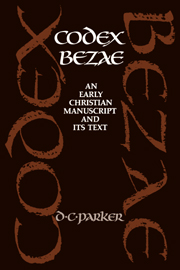Book contents
- Front Matter
- Contents
- List of illustrations
- Preface
- Abbreviations and textual conventions
- Introduction
- PART I The palaeography
- PART II The scribe and the tradition
- PART III The correctors
- PART IV The bilingual tradition
- Part V Text and codex
- Chapter Fifteen The origins of the Codex Bezae
- Chapter Sixteen The history of a text
- Appendices
- Plates
- Notes on the plates
- Indexes
Chapter Fifteen - The origins of the Codex Bezae
Published online by Cambridge University Press: 09 November 2009
- Front Matter
- Contents
- List of illustrations
- Preface
- Abbreviations and textual conventions
- Introduction
- PART I The palaeography
- PART II The scribe and the tradition
- PART III The correctors
- PART IV The bilingual tradition
- Part V Text and codex
- Chapter Fifteen The origins of the Codex Bezae
- Chapter Sixteen The history of a text
- Appendices
- Plates
- Notes on the plates
- Indexes
Summary
Having studied the internal evidence that provides information about the origins of Codex Bezae, that is to say, the character of the hand, the particularities of the correctors, and the nature of the text, we are in a position to enquire as to its place of origin and early history, setting the internal evidence within the context of the history of the church and of contemporary culture.
A remarkably varied number of areas have been suggested as the homeland of D, ranging from Gaul to Alexandria and from Africa to Jerusalem. Since the palaeographical evidence in favour of an Eastern origin cannot be ignored, we can pass over the Western theories quite quickly, to examine more thoroughly the Eastern possibilities.
Perhaps the most remarkable theory of all is that advanced by J. A. Bengel, who, in Schulz's words, dared to conclude that the manuscript had been copied in Britain, on the basis of a comparison with the Anglo-Saxon version (Disputatio, p. 7). It is only fair to point out that this claim is found in the posthumous (1763) edition of his apparatus criticus (Vol. 1, §28), edited by his son-in-law Philip David Burk.
The theory that the manuscript came from Southern Gaul goes back to J. M. A. Scholz (1794–1852; Novum Testamentum, Leipzig, 1830–6, Proleg. i.xl; ciii, cited by Scrivener, p. xxxi). It was later supported by Scrivener, Harris, and Sneyders de Vogel.
- Type
- Chapter
- Information
- Codex BezaeAn Early Christian Manuscript and its Text, pp. 261 - 278Publisher: Cambridge University PressPrint publication year: 1992

